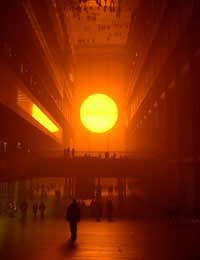London: Capital of the Art World

During the late 1980s and early 1990s London enjoyed a slow emergence as the capital of the art world. Many factors came in to play here not least the sharp rise in popularity of British art, spearheaded by the ‘Young British Artists’ (aka YBA’s), bought and promoted principally by Charles Saatchi. Other factors included Britain’s economic status (which sharply improved in the late 90s) in contrast to flagging economies in the rest of Europe. It seemed that many years of poor economic performance, underinvestment in public services and a marginalisation of the arts spawned the YBA, who first exhibited together whilst Britain resided under the rule of Thatcher, who is held largely responsible for our initial economic demise. The work of the YBA’s was sharp, witty and radical, often aiming to upset both the art establishment and the wider Thatcherite society we lived in. A subsequent improvement in the economy under the management of the Blair government, which came to power in 1997, fostered economic conditions that made the wholesale renaissance of British art possible.
A Resilient Art Market
There is a simple equation that governs the success and decline of the art scene: when the economy performs badly and times are hard, artists tend to gather in rebellion, though few people can afford to buy their work! When, in contrast, the economy picks up, those artists who had previously fought the establishment have their works bought by them, and become less radical, whilst artists in other areas of the world gather in order to later become dominant in the world arts scene. Though this is slightly cynical, it appears in the case of the recent emergence of British art on to the world scene, to be partially true. Charles Saatchi, an advertising tycoon who had for years run Thatcher’s media campaigns was later to become patron to a whole generation who had despised Thatcher’s rule.However, this appears not to all be bad, as the growth in the British economy in the late 90s, and the subsequent buoyancy of the art market occurred during a fairly liberal period of governance. There appears to be little to stand in the way of the British artist saying precisely what they want – in fact, artists are often lauded for their bad behaviour, and the lurid statements they make. Even controversy has stood to improve the position of the British arts, as the ‘Sensations’ art show proved, when in 1997, a painting of Myra Hindley was temporarily removed for the anger that it caused.
A curious factor about the emergence of the British art market is that the economy that has supported it, though slowing slightly has not at any point in ten years appeared to dwindle. All this time, the art world has strengthened, buoyed in London by the opening of Tate Modern (2001), the high quality of work on display at other major venues (such as Velazquez, recently on show at the National Gallery) and the emergence of tens to hundreds of small gallery venues across East and South London. This in turn has promoted a growth in tourism, all of which points to the fact that whilst other art markets and economies are emerging (such as in New York and Berlin) the dominance of the U.K. market remains unchallenged.
The continuing success of London based auction houses such as Sotheby’s, Christie’s and Bonham’s contributes further to this unprecedented success, there never before having been such a sustained simultaneous growth in interest in both contemporary and historical artworks.








